BIS Report: Collaboration's Importance and Effectiveness Analysis
VerifiedAdded on 2023/04/10
|13
|2090
|216
Report
AI Summary
This report analyzes the importance and effectiveness of collaboration within Business Information Systems (BIS). It defines BIS as a set of interrelated procedures utilizing IT infrastructure for business enterprises, designed to ease decision-making. The report discusses the characteristics of BIS, emphasizing their dynamic nature, proactivity, and cost-effectiveness. It explores different forms of collaboration among enterprise systems, knowledge management systems, and business intelligence systems, highlighting their role in increasing efficiency and employee productivity. The report also examines the strategic significance of BIS, particularly in enabling effective decision-making and managing information needs at various organizational levels, supported by examples like ERP systems. The report concludes that collaboration in BIS is crucial for efficiently managing business processes and supporting strategic information needs.

Running head:BUSINESS INFORMATION SYSTEMS
Business Information Systems
Name of Student
Name of University
Author Note
Business Information Systems
Name of Student
Name of University
Author Note
Paraphrase This Document
Need a fresh take? Get an instant paraphrase of this document with our AI Paraphraser
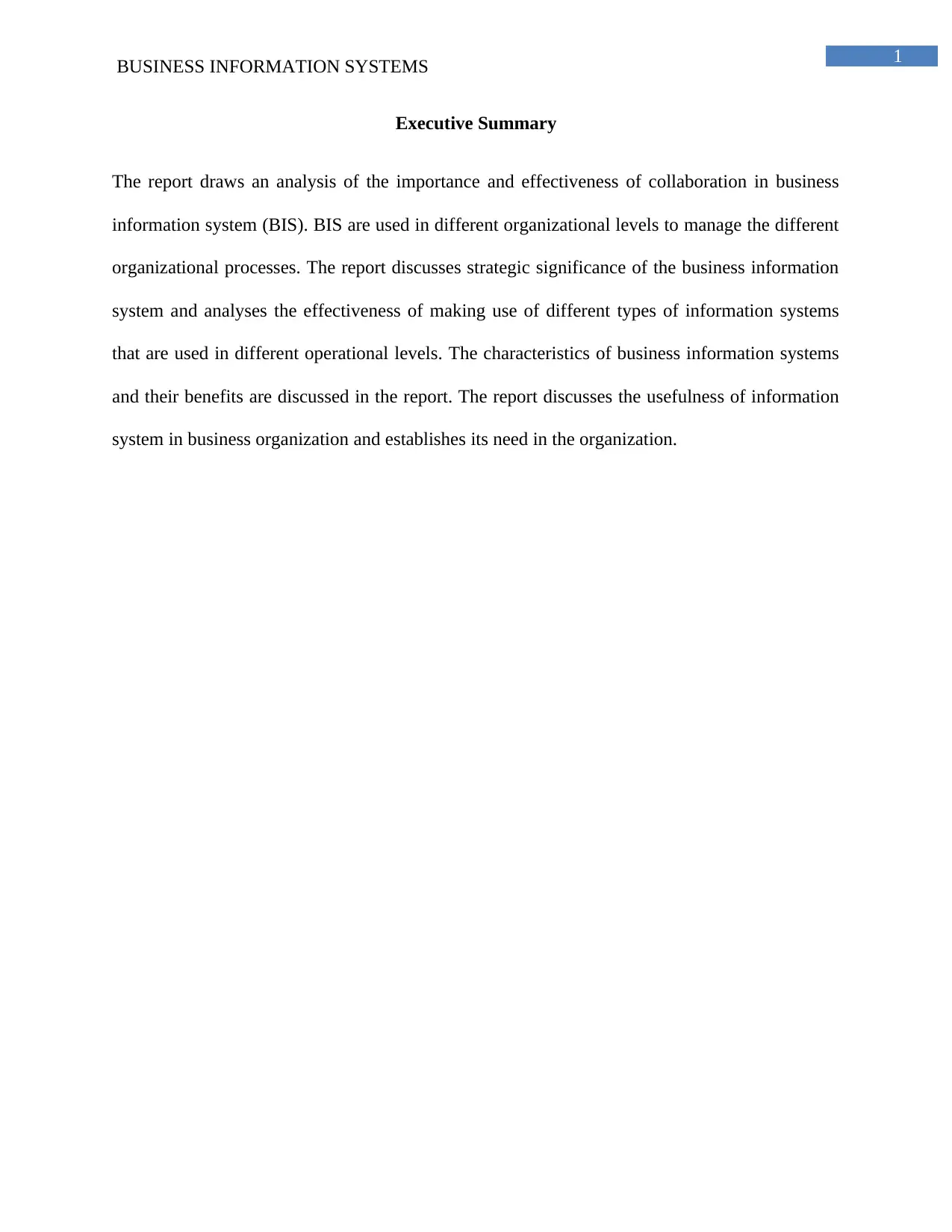
1
BUSINESS INFORMATION SYSTEMS
Executive Summary
The report draws an analysis of the importance and effectiveness of collaboration in business
information system (BIS). BIS are used in different organizational levels to manage the different
organizational processes. The report discusses strategic significance of the business information
system and analyses the effectiveness of making use of different types of information systems
that are used in different operational levels. The characteristics of business information systems
and their benefits are discussed in the report. The report discusses the usefulness of information
system in business organization and establishes its need in the organization.
BUSINESS INFORMATION SYSTEMS
Executive Summary
The report draws an analysis of the importance and effectiveness of collaboration in business
information system (BIS). BIS are used in different organizational levels to manage the different
organizational processes. The report discusses strategic significance of the business information
system and analyses the effectiveness of making use of different types of information systems
that are used in different operational levels. The characteristics of business information systems
and their benefits are discussed in the report. The report discusses the usefulness of information
system in business organization and establishes its need in the organization.
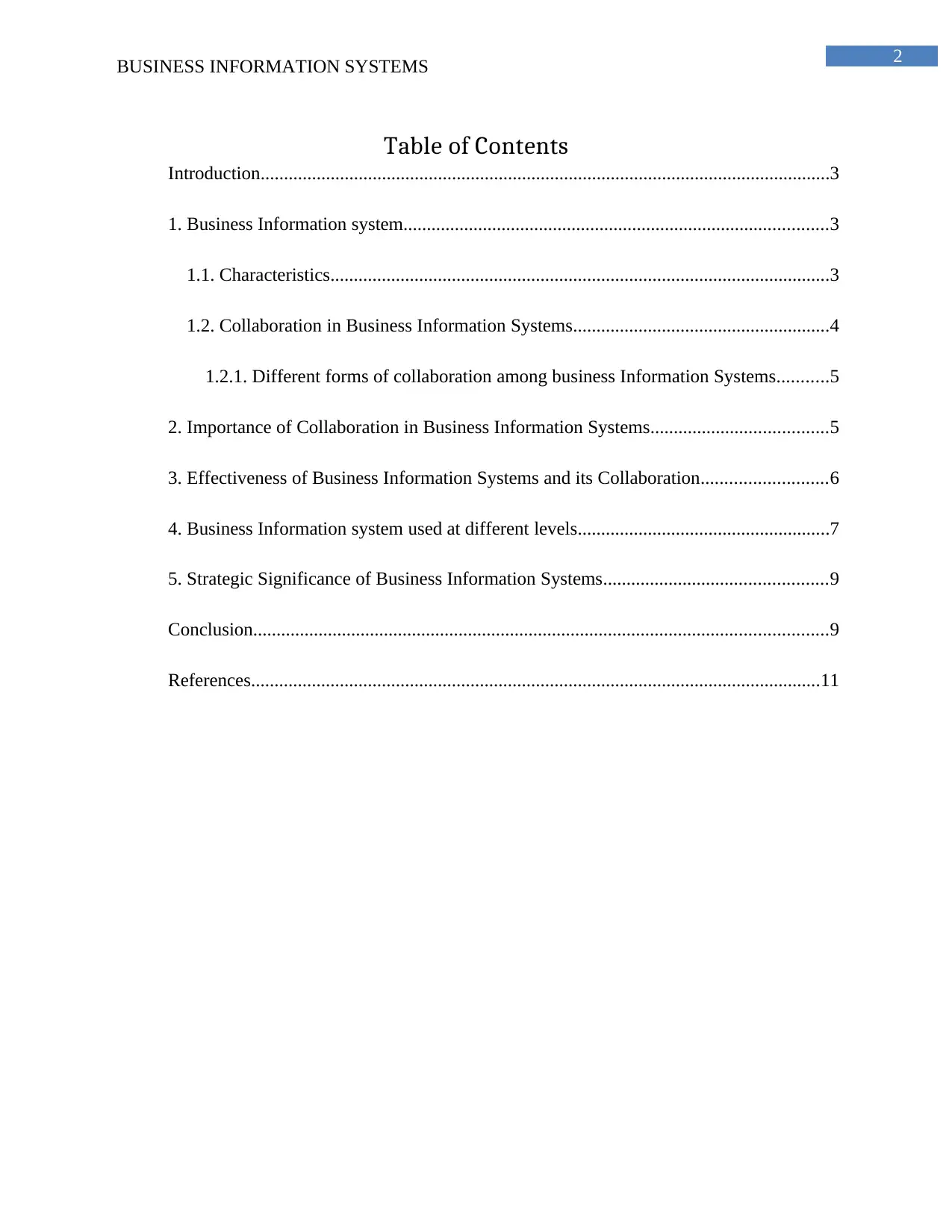
2
BUSINESS INFORMATION SYSTEMS
Table of Contents
Introduction..........................................................................................................................3
1. Business Information system...........................................................................................3
1.1. Characteristics...........................................................................................................3
1.2. Collaboration in Business Information Systems.......................................................4
1.2.1. Different forms of collaboration among business Information Systems...........5
2. Importance of Collaboration in Business Information Systems......................................5
3. Effectiveness of Business Information Systems and its Collaboration...........................6
4. Business Information system used at different levels......................................................7
5. Strategic Significance of Business Information Systems................................................9
Conclusion...........................................................................................................................9
References..........................................................................................................................11
BUSINESS INFORMATION SYSTEMS
Table of Contents
Introduction..........................................................................................................................3
1. Business Information system...........................................................................................3
1.1. Characteristics...........................................................................................................3
1.2. Collaboration in Business Information Systems.......................................................4
1.2.1. Different forms of collaboration among business Information Systems...........5
2. Importance of Collaboration in Business Information Systems......................................5
3. Effectiveness of Business Information Systems and its Collaboration...........................6
4. Business Information system used at different levels......................................................7
5. Strategic Significance of Business Information Systems................................................9
Conclusion...........................................................................................................................9
References..........................................................................................................................11
⊘ This is a preview!⊘
Do you want full access?
Subscribe today to unlock all pages.

Trusted by 1+ million students worldwide
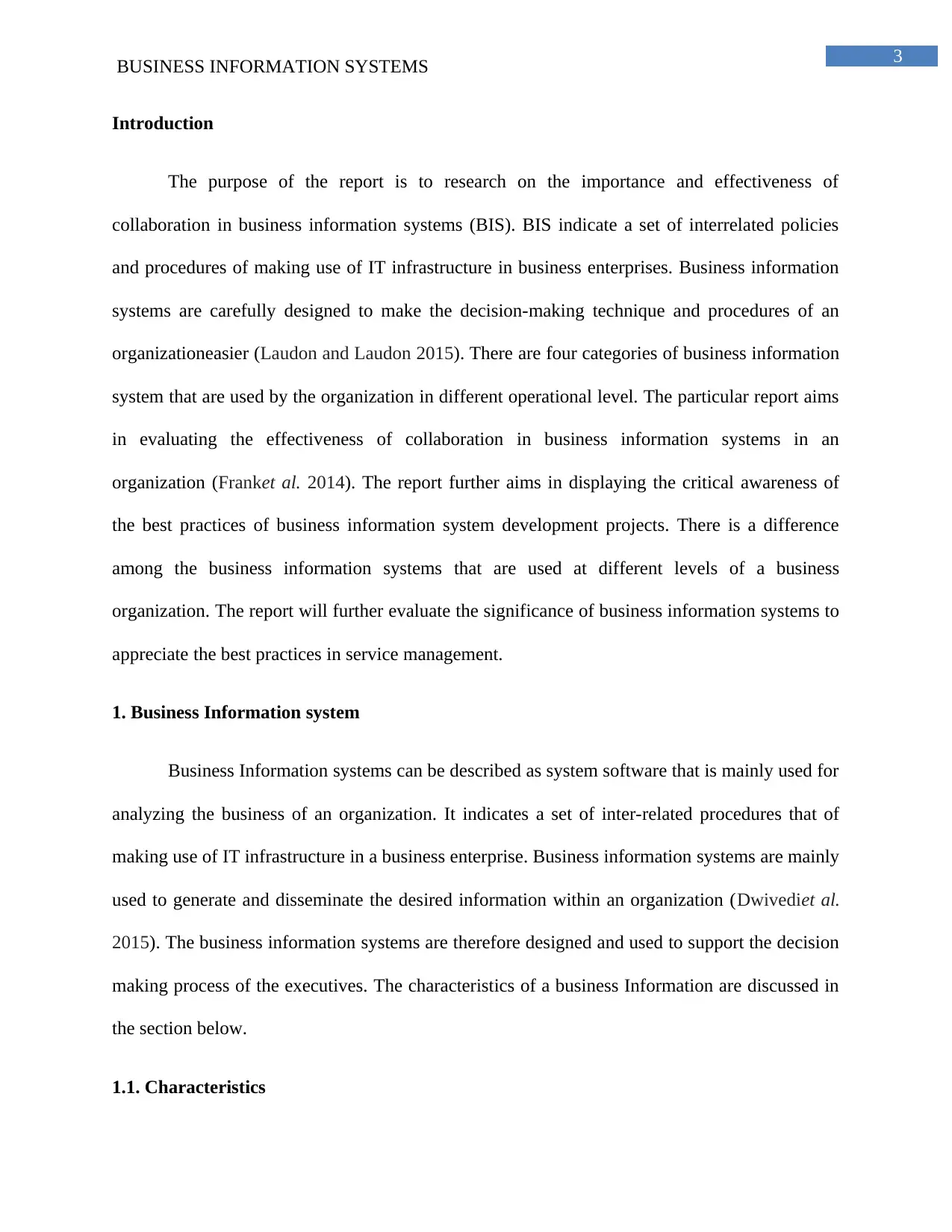
3
BUSINESS INFORMATION SYSTEMS
Introduction
The purpose of the report is to research on the importance and effectiveness of
collaboration in business information systems (BIS). BIS indicate a set of interrelated policies
and procedures of making use of IT infrastructure in business enterprises. Business information
systems are carefully designed to make the decision-making technique and procedures of an
organizationeasier (Laudon and Laudon 2015). There are four categories of business information
system that are used by the organization in different operational level. The particular report aims
in evaluating the effectiveness of collaboration in business information systems in an
organization (Franket al. 2014). The report further aims in displaying the critical awareness of
the best practices of business information system development projects. There is a difference
among the business information systems that are used at different levels of a business
organization. The report will further evaluate the significance of business information systems to
appreciate the best practices in service management.
1. Business Information system
Business Information systems can be described as system software that is mainly used for
analyzing the business of an organization. It indicates a set of inter-related procedures that of
making use of IT infrastructure in a business enterprise. Business information systems are mainly
used to generate and disseminate the desired information within an organization (Dwivediet al.
2015). The business information systems are therefore designed and used to support the decision
making process of the executives. The characteristics of a business Information are discussed in
the section below.
1.1. Characteristics
BUSINESS INFORMATION SYSTEMS
Introduction
The purpose of the report is to research on the importance and effectiveness of
collaboration in business information systems (BIS). BIS indicate a set of interrelated policies
and procedures of making use of IT infrastructure in business enterprises. Business information
systems are carefully designed to make the decision-making technique and procedures of an
organizationeasier (Laudon and Laudon 2015). There are four categories of business information
system that are used by the organization in different operational level. The particular report aims
in evaluating the effectiveness of collaboration in business information systems in an
organization (Franket al. 2014). The report further aims in displaying the critical awareness of
the best practices of business information system development projects. There is a difference
among the business information systems that are used at different levels of a business
organization. The report will further evaluate the significance of business information systems to
appreciate the best practices in service management.
1. Business Information system
Business Information systems can be described as system software that is mainly used for
analyzing the business of an organization. It indicates a set of inter-related procedures that of
making use of IT infrastructure in a business enterprise. Business information systems are mainly
used to generate and disseminate the desired information within an organization (Dwivediet al.
2015). The business information systems are therefore designed and used to support the decision
making process of the executives. The characteristics of a business Information are discussed in
the section below.
1.1. Characteristics
Paraphrase This Document
Need a fresh take? Get an instant paraphrase of this document with our AI Paraphraser
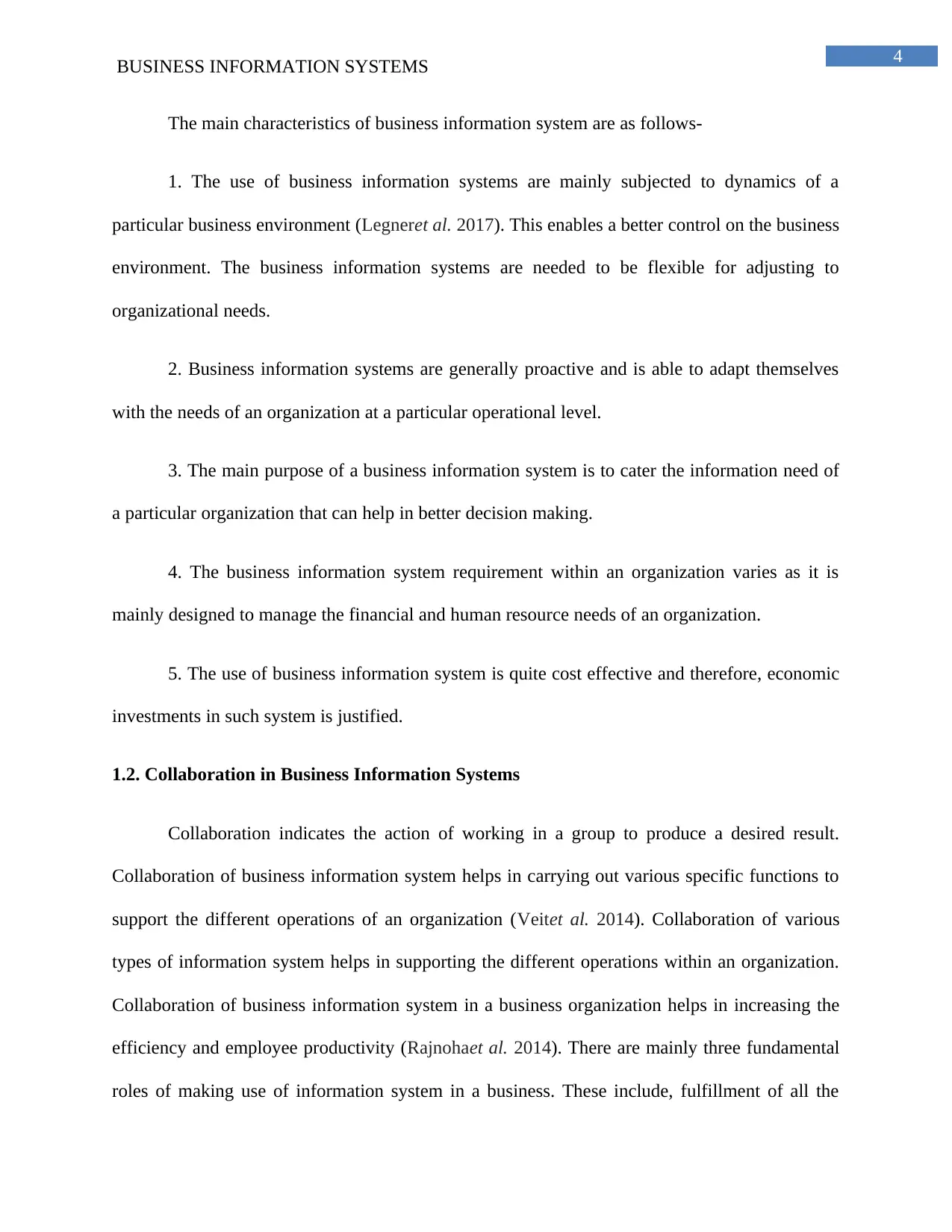
4
BUSINESS INFORMATION SYSTEMS
The main characteristics of business information system are as follows-
1. The use of business information systems are mainly subjected to dynamics of a
particular business environment (Legneret al. 2017). This enables a better control on the business
environment. The business information systems are needed to be flexible for adjusting to
organizational needs.
2. Business information systems are generally proactive and is able to adapt themselves
with the needs of an organization at a particular operational level.
3. The main purpose of a business information system is to cater the information need of
a particular organization that can help in better decision making.
4. The business information system requirement within an organization varies as it is
mainly designed to manage the financial and human resource needs of an organization.
5. The use of business information system is quite cost effective and therefore, economic
investments in such system is justified.
1.2. Collaboration in Business Information Systems
Collaboration indicates the action of working in a group to produce a desired result.
Collaboration of business information system helps in carrying out various specific functions to
support the different operations of an organization (Veitet al. 2014). Collaboration of various
types of information system helps in supporting the different operations within an organization.
Collaboration of business information system in a business organization helps in increasing the
efficiency and employee productivity (Rajnohaet al. 2014). There are mainly three fundamental
roles of making use of information system in a business. These include, fulfillment of all the
BUSINESS INFORMATION SYSTEMS
The main characteristics of business information system are as follows-
1. The use of business information systems are mainly subjected to dynamics of a
particular business environment (Legneret al. 2017). This enables a better control on the business
environment. The business information systems are needed to be flexible for adjusting to
organizational needs.
2. Business information systems are generally proactive and is able to adapt themselves
with the needs of an organization at a particular operational level.
3. The main purpose of a business information system is to cater the information need of
a particular organization that can help in better decision making.
4. The business information system requirement within an organization varies as it is
mainly designed to manage the financial and human resource needs of an organization.
5. The use of business information system is quite cost effective and therefore, economic
investments in such system is justified.
1.2. Collaboration in Business Information Systems
Collaboration indicates the action of working in a group to produce a desired result.
Collaboration of business information system helps in carrying out various specific functions to
support the different operations of an organization (Veitet al. 2014). Collaboration of various
types of information system helps in supporting the different operations within an organization.
Collaboration of business information system in a business organization helps in increasing the
efficiency and employee productivity (Rajnohaet al. 2014). There are mainly three fundamental
roles of making use of information system in a business. These include, fulfillment of all the
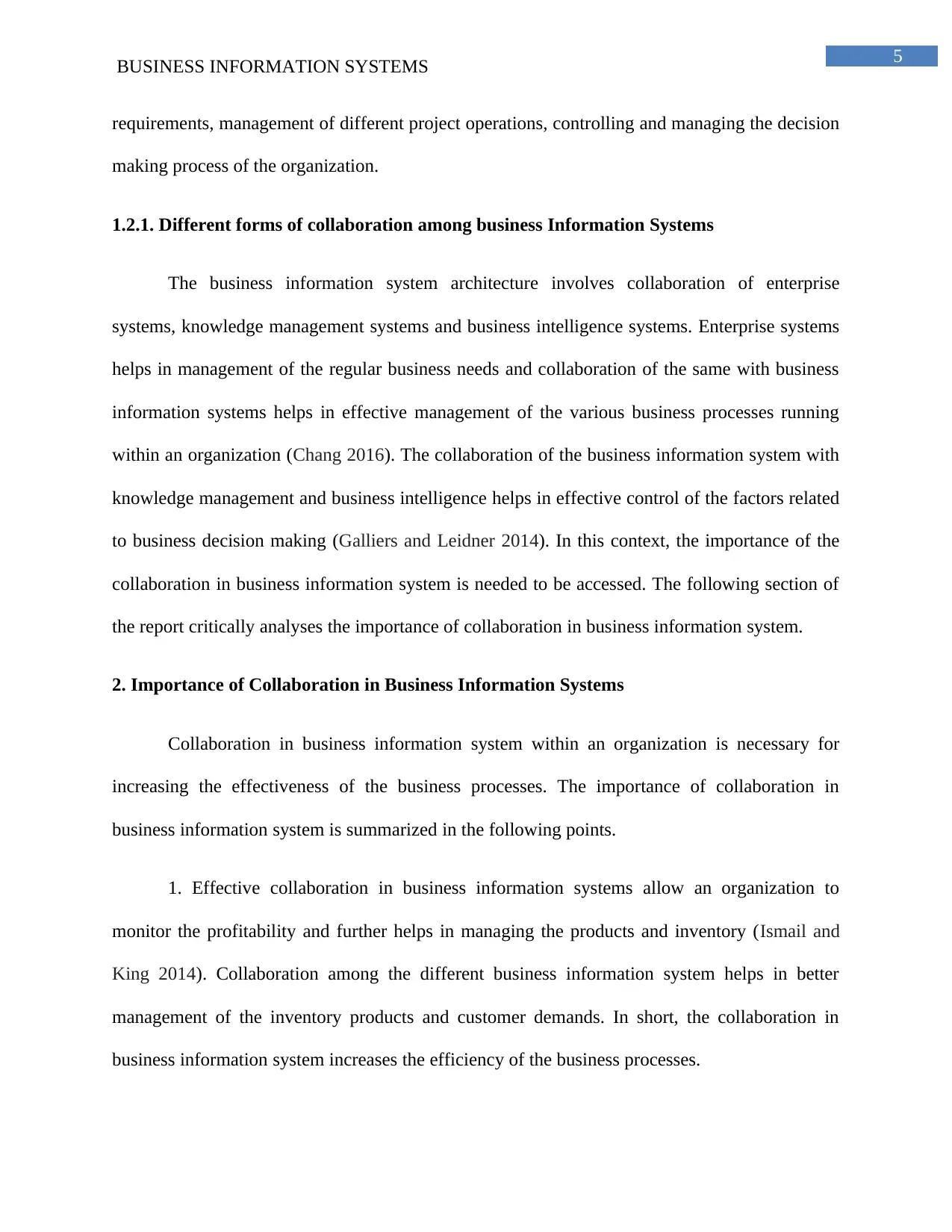
5
BUSINESS INFORMATION SYSTEMS
requirements, management of different project operations, controlling and managing the decision
making process of the organization.
1.2.1. Different forms of collaboration among business Information Systems
The business information system architecture involves collaboration of enterprise
systems, knowledge management systems and business intelligence systems. Enterprise systems
helps in management of the regular business needs and collaboration of the same with business
information systems helps in effective management of the various business processes running
within an organization (Chang 2016). The collaboration of the business information system with
knowledge management and business intelligence helps in effective control of the factors related
to business decision making (Galliers and Leidner 2014). In this context, the importance of the
collaboration in business information system is needed to be accessed. The following section of
the report critically analyses the importance of collaboration in business information system.
2. Importance of Collaboration in Business Information Systems
Collaboration in business information system within an organization is necessary for
increasing the effectiveness of the business processes. The importance of collaboration in
business information system is summarized in the following points.
1. Effective collaboration in business information systems allow an organization to
monitor the profitability and further helps in managing the products and inventory (Ismail and
King 2014). Collaboration among the different business information system helps in better
management of the inventory products and customer demands. In short, the collaboration in
business information system increases the efficiency of the business processes.
BUSINESS INFORMATION SYSTEMS
requirements, management of different project operations, controlling and managing the decision
making process of the organization.
1.2.1. Different forms of collaboration among business Information Systems
The business information system architecture involves collaboration of enterprise
systems, knowledge management systems and business intelligence systems. Enterprise systems
helps in management of the regular business needs and collaboration of the same with business
information systems helps in effective management of the various business processes running
within an organization (Chang 2016). The collaboration of the business information system with
knowledge management and business intelligence helps in effective control of the factors related
to business decision making (Galliers and Leidner 2014). In this context, the importance of the
collaboration in business information system is needed to be accessed. The following section of
the report critically analyses the importance of collaboration in business information system.
2. Importance of Collaboration in Business Information Systems
Collaboration in business information system within an organization is necessary for
increasing the effectiveness of the business processes. The importance of collaboration in
business information system is summarized in the following points.
1. Effective collaboration in business information systems allow an organization to
monitor the profitability and further helps in managing the products and inventory (Ismail and
King 2014). Collaboration among the different business information system helps in better
management of the inventory products and customer demands. In short, the collaboration in
business information system increases the efficiency of the business processes.
⊘ This is a preview!⊘
Do you want full access?
Subscribe today to unlock all pages.

Trusted by 1+ million students worldwide
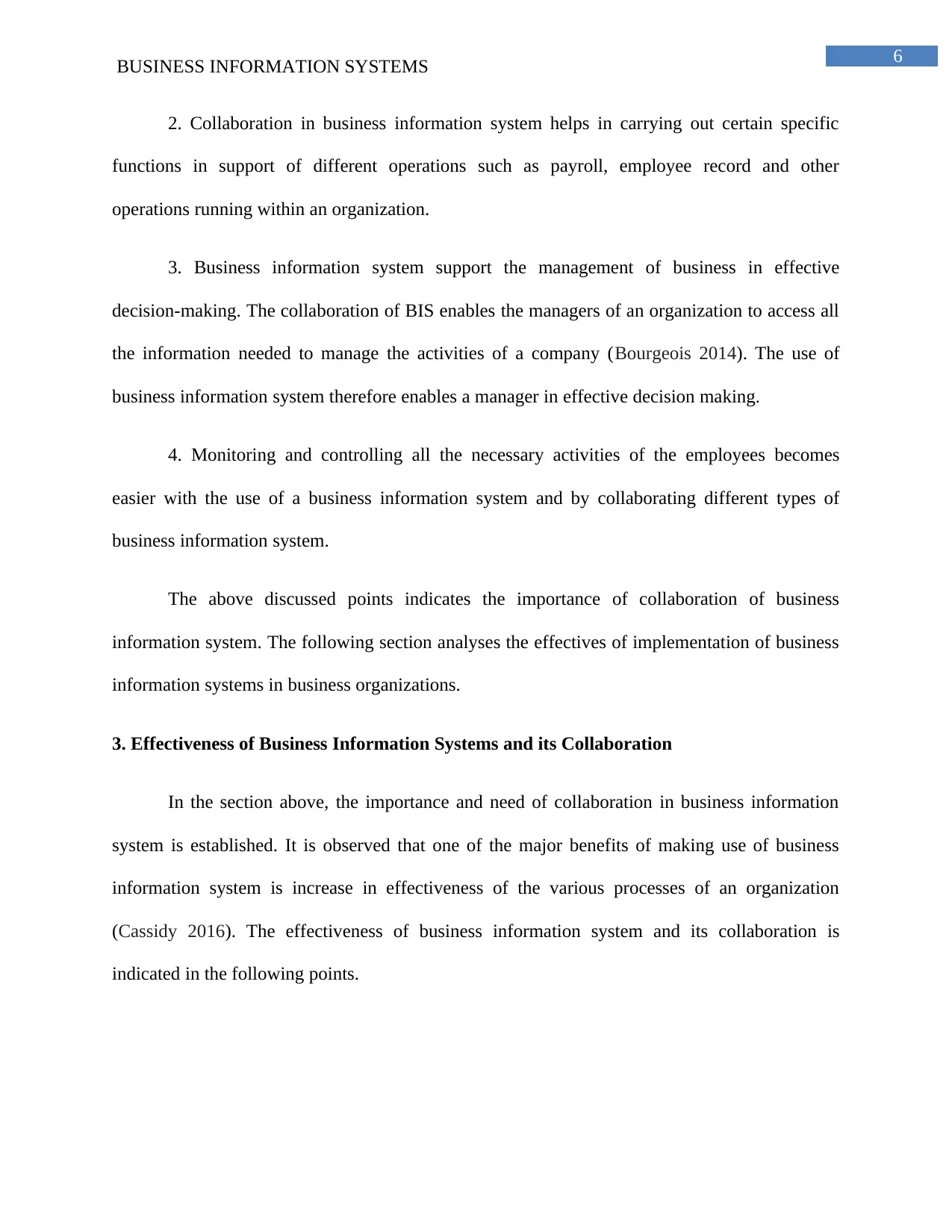
6
BUSINESS INFORMATION SYSTEMS
2. Collaboration in business information system helps in carrying out certain specific
functions in support of different operations such as payroll, employee record and other
operations running within an organization.
3. Business information system support the management of business in effective
decision-making. The collaboration of BIS enables the managers of an organization to access all
the information needed to manage the activities of a company (Bourgeois 2014). The use of
business information system therefore enables a manager in effective decision making.
4. Monitoring and controlling all the necessary activities of the employees becomes
easier with the use of a business information system and by collaborating different types of
business information system.
The above discussed points indicates the importance of collaboration of business
information system. The following section analyses the effectives of implementation of business
information systems in business organizations.
3. Effectiveness of Business Information Systems and its Collaboration
In the section above, the importance and need of collaboration in business information
system is established. It is observed that one of the major benefits of making use of business
information system is increase in effectiveness of the various processes of an organization
(Cassidy 2016). The effectiveness of business information system and its collaboration is
indicated in the following points.
BUSINESS INFORMATION SYSTEMS
2. Collaboration in business information system helps in carrying out certain specific
functions in support of different operations such as payroll, employee record and other
operations running within an organization.
3. Business information system support the management of business in effective
decision-making. The collaboration of BIS enables the managers of an organization to access all
the information needed to manage the activities of a company (Bourgeois 2014). The use of
business information system therefore enables a manager in effective decision making.
4. Monitoring and controlling all the necessary activities of the employees becomes
easier with the use of a business information system and by collaborating different types of
business information system.
The above discussed points indicates the importance of collaboration of business
information system. The following section analyses the effectives of implementation of business
information systems in business organizations.
3. Effectiveness of Business Information Systems and its Collaboration
In the section above, the importance and need of collaboration in business information
system is established. It is observed that one of the major benefits of making use of business
information system is increase in effectiveness of the various processes of an organization
(Cassidy 2016). The effectiveness of business information system and its collaboration is
indicated in the following points.
Paraphrase This Document
Need a fresh take? Get an instant paraphrase of this document with our AI Paraphraser
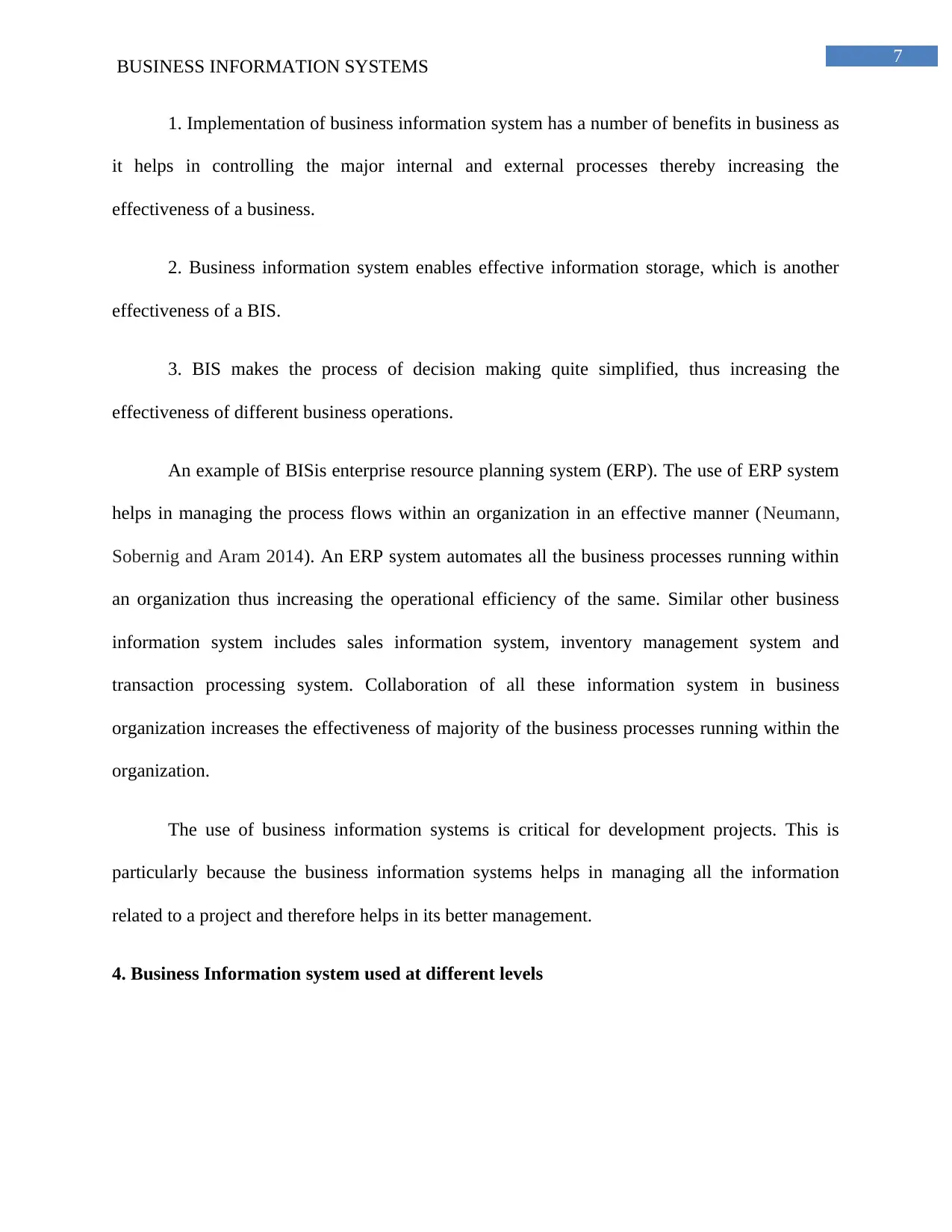
7
BUSINESS INFORMATION SYSTEMS
1. Implementation of business information system has a number of benefits in business as
it helps in controlling the major internal and external processes thereby increasing the
effectiveness of a business.
2. Business information system enables effective information storage, which is another
effectiveness of a BIS.
3. BIS makes the process of decision making quite simplified, thus increasing the
effectiveness of different business operations.
An example of BISis enterprise resource planning system (ERP). The use of ERP system
helps in managing the process flows within an organization in an effective manner (Neumann,
Sobernig and Aram 2014). An ERP system automates all the business processes running within
an organization thus increasing the operational efficiency of the same. Similar other business
information system includes sales information system, inventory management system and
transaction processing system. Collaboration of all these information system in business
organization increases the effectiveness of majority of the business processes running within the
organization.
The use of business information systems is critical for development projects. This is
particularly because the business information systems helps in managing all the information
related to a project and therefore helps in its better management.
4. Business Information system used at different levels
BUSINESS INFORMATION SYSTEMS
1. Implementation of business information system has a number of benefits in business as
it helps in controlling the major internal and external processes thereby increasing the
effectiveness of a business.
2. Business information system enables effective information storage, which is another
effectiveness of a BIS.
3. BIS makes the process of decision making quite simplified, thus increasing the
effectiveness of different business operations.
An example of BISis enterprise resource planning system (ERP). The use of ERP system
helps in managing the process flows within an organization in an effective manner (Neumann,
Sobernig and Aram 2014). An ERP system automates all the business processes running within
an organization thus increasing the operational efficiency of the same. Similar other business
information system includes sales information system, inventory management system and
transaction processing system. Collaboration of all these information system in business
organization increases the effectiveness of majority of the business processes running within the
organization.
The use of business information systems is critical for development projects. This is
particularly because the business information systems helps in managing all the information
related to a project and therefore helps in its better management.
4. Business Information system used at different levels
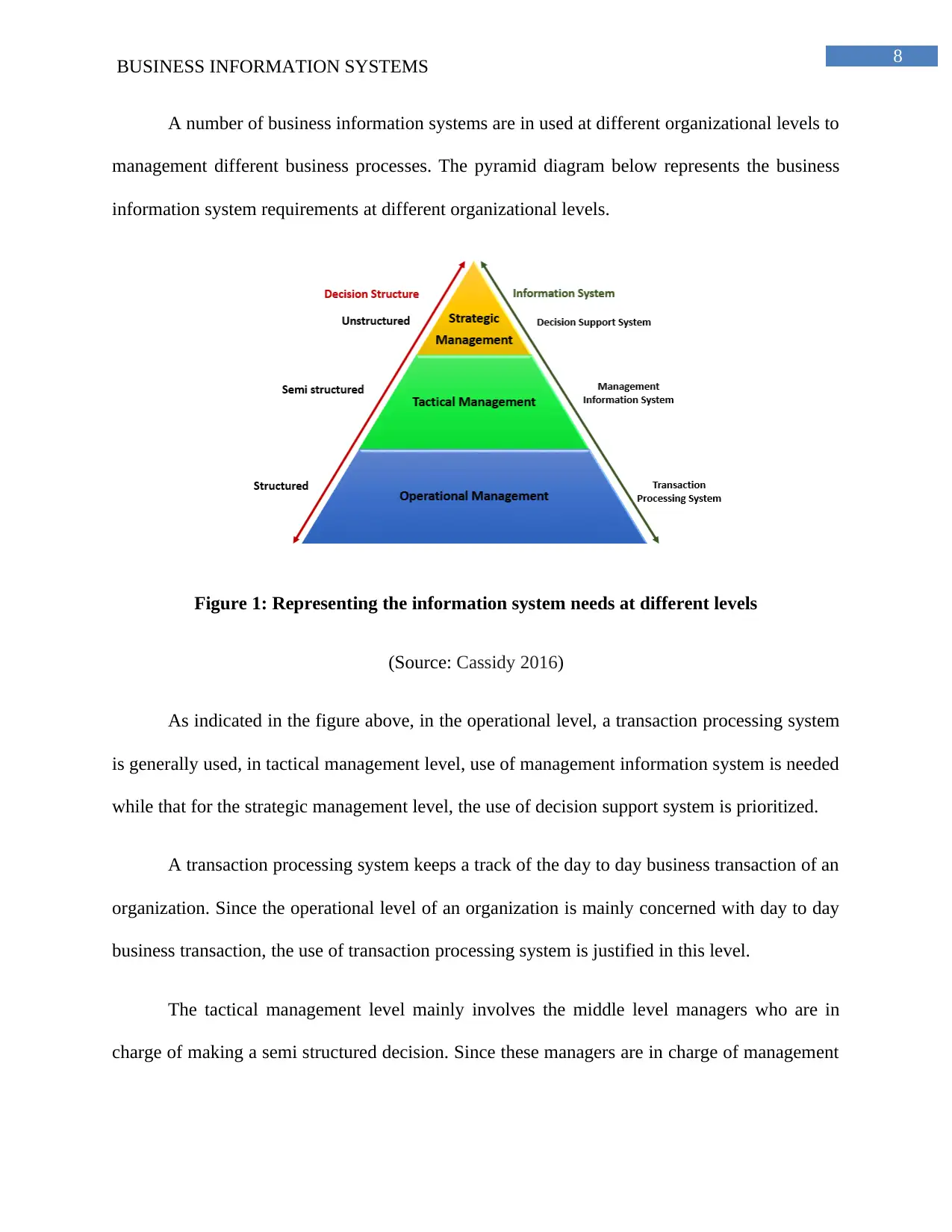
8
BUSINESS INFORMATION SYSTEMS
A number of business information systems are in used at different organizational levels to
management different business processes. The pyramid diagram below represents the business
information system requirements at different organizational levels.
Figure 1: Representing the information system needs at different levels
(Source: Cassidy 2016)
As indicated in the figure above, in the operational level, a transaction processing system
is generally used, in tactical management level, use of management information system is needed
while that for the strategic management level, the use of decision support system is prioritized.
A transaction processing system keeps a track of the day to day business transaction of an
organization. Since the operational level of an organization is mainly concerned with day to day
business transaction, the use of transaction processing system is justified in this level.
The tactical management level mainly involves the middle level managers who are in
charge of making a semi structured decision. Since these managers are in charge of management
BUSINESS INFORMATION SYSTEMS
A number of business information systems are in used at different organizational levels to
management different business processes. The pyramid diagram below represents the business
information system requirements at different organizational levels.
Figure 1: Representing the information system needs at different levels
(Source: Cassidy 2016)
As indicated in the figure above, in the operational level, a transaction processing system
is generally used, in tactical management level, use of management information system is needed
while that for the strategic management level, the use of decision support system is prioritized.
A transaction processing system keeps a track of the day to day business transaction of an
organization. Since the operational level of an organization is mainly concerned with day to day
business transaction, the use of transaction processing system is justified in this level.
The tactical management level mainly involves the middle level managers who are in
charge of making a semi structured decision. Since these managers are in charge of management
⊘ This is a preview!⊘
Do you want full access?
Subscribe today to unlock all pages.

Trusted by 1+ million students worldwide
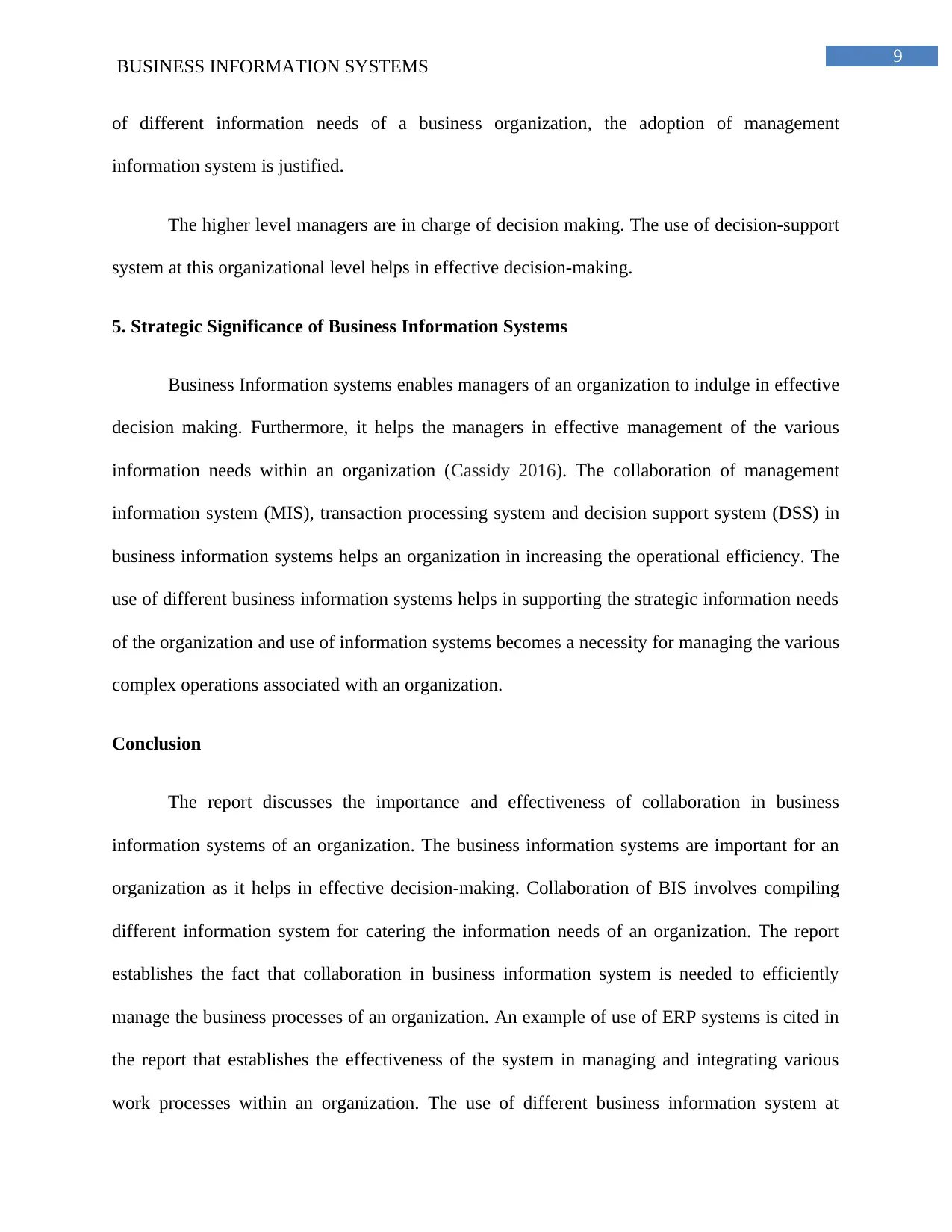
9
BUSINESS INFORMATION SYSTEMS
of different information needs of a business organization, the adoption of management
information system is justified.
The higher level managers are in charge of decision making. The use of decision-support
system at this organizational level helps in effective decision-making.
5. Strategic Significance of Business Information Systems
Business Information systems enables managers of an organization to indulge in effective
decision making. Furthermore, it helps the managers in effective management of the various
information needs within an organization (Cassidy 2016). The collaboration of management
information system (MIS), transaction processing system and decision support system (DSS) in
business information systems helps an organization in increasing the operational efficiency. The
use of different business information systems helps in supporting the strategic information needs
of the organization and use of information systems becomes a necessity for managing the various
complex operations associated with an organization.
Conclusion
The report discusses the importance and effectiveness of collaboration in business
information systems of an organization. The business information systems are important for an
organization as it helps in effective decision-making. Collaboration of BIS involves compiling
different information system for catering the information needs of an organization. The report
establishes the fact that collaboration in business information system is needed to efficiently
manage the business processes of an organization. An example of use of ERP systems is cited in
the report that establishes the effectiveness of the system in managing and integrating various
work processes within an organization. The use of different business information system at
BUSINESS INFORMATION SYSTEMS
of different information needs of a business organization, the adoption of management
information system is justified.
The higher level managers are in charge of decision making. The use of decision-support
system at this organizational level helps in effective decision-making.
5. Strategic Significance of Business Information Systems
Business Information systems enables managers of an organization to indulge in effective
decision making. Furthermore, it helps the managers in effective management of the various
information needs within an organization (Cassidy 2016). The collaboration of management
information system (MIS), transaction processing system and decision support system (DSS) in
business information systems helps an organization in increasing the operational efficiency. The
use of different business information systems helps in supporting the strategic information needs
of the organization and use of information systems becomes a necessity for managing the various
complex operations associated with an organization.
Conclusion
The report discusses the importance and effectiveness of collaboration in business
information systems of an organization. The business information systems are important for an
organization as it helps in effective decision-making. Collaboration of BIS involves compiling
different information system for catering the information needs of an organization. The report
establishes the fact that collaboration in business information system is needed to efficiently
manage the business processes of an organization. An example of use of ERP systems is cited in
the report that establishes the effectiveness of the system in managing and integrating various
work processes within an organization. The use of different business information system at
Paraphrase This Document
Need a fresh take? Get an instant paraphrase of this document with our AI Paraphraser

10
BUSINESS INFORMATION SYSTEMS
various organizational levels such as operational level, management level and strategic level are
discussed. It is observed that the use of business information systems helps in effective
management of the business processes and further helps in effective decision making.
BUSINESS INFORMATION SYSTEMS
various organizational levels such as operational level, management level and strategic level are
discussed. It is observed that the use of business information systems helps in effective
management of the business processes and further helps in effective decision making.
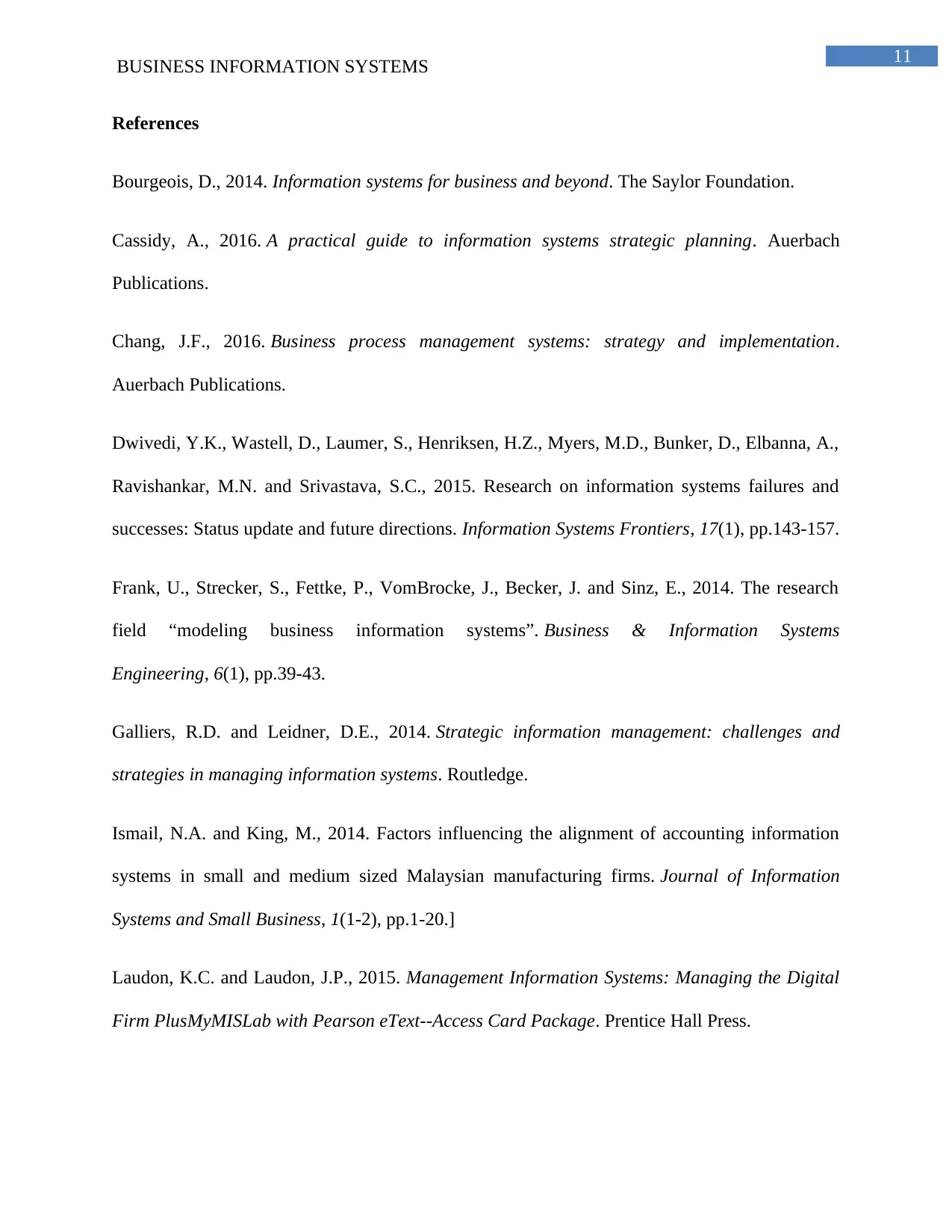
11
BUSINESS INFORMATION SYSTEMS
References
Bourgeois, D., 2014. Information systems for business and beyond. The Saylor Foundation.
Cassidy, A., 2016. A practical guide to information systems strategic planning. Auerbach
Publications.
Chang, J.F., 2016. Business process management systems: strategy and implementation.
Auerbach Publications.
Dwivedi, Y.K., Wastell, D., Laumer, S., Henriksen, H.Z., Myers, M.D., Bunker, D., Elbanna, A.,
Ravishankar, M.N. and Srivastava, S.C., 2015. Research on information systems failures and
successes: Status update and future directions. Information Systems Frontiers, 17(1), pp.143-157.
Frank, U., Strecker, S., Fettke, P., VomBrocke, J., Becker, J. and Sinz, E., 2014. The research
field “modeling business information systems”. Business & Information Systems
Engineering, 6(1), pp.39-43.
Galliers, R.D. and Leidner, D.E., 2014. Strategic information management: challenges and
strategies in managing information systems. Routledge.
Ismail, N.A. and King, M., 2014. Factors influencing the alignment of accounting information
systems in small and medium sized Malaysian manufacturing firms. Journal of Information
Systems and Small Business, 1(1-2), pp.1-20.]
Laudon, K.C. and Laudon, J.P., 2015. Management Information Systems: Managing the Digital
Firm PlusMyMISLab with Pearson eText--Access Card Package. Prentice Hall Press.
BUSINESS INFORMATION SYSTEMS
References
Bourgeois, D., 2014. Information systems for business and beyond. The Saylor Foundation.
Cassidy, A., 2016. A practical guide to information systems strategic planning. Auerbach
Publications.
Chang, J.F., 2016. Business process management systems: strategy and implementation.
Auerbach Publications.
Dwivedi, Y.K., Wastell, D., Laumer, S., Henriksen, H.Z., Myers, M.D., Bunker, D., Elbanna, A.,
Ravishankar, M.N. and Srivastava, S.C., 2015. Research on information systems failures and
successes: Status update and future directions. Information Systems Frontiers, 17(1), pp.143-157.
Frank, U., Strecker, S., Fettke, P., VomBrocke, J., Becker, J. and Sinz, E., 2014. The research
field “modeling business information systems”. Business & Information Systems
Engineering, 6(1), pp.39-43.
Galliers, R.D. and Leidner, D.E., 2014. Strategic information management: challenges and
strategies in managing information systems. Routledge.
Ismail, N.A. and King, M., 2014. Factors influencing the alignment of accounting information
systems in small and medium sized Malaysian manufacturing firms. Journal of Information
Systems and Small Business, 1(1-2), pp.1-20.]
Laudon, K.C. and Laudon, J.P., 2015. Management Information Systems: Managing the Digital
Firm PlusMyMISLab with Pearson eText--Access Card Package. Prentice Hall Press.
⊘ This is a preview!⊘
Do you want full access?
Subscribe today to unlock all pages.

Trusted by 1+ million students worldwide
1 out of 13
Related Documents
Your All-in-One AI-Powered Toolkit for Academic Success.
+13062052269
info@desklib.com
Available 24*7 on WhatsApp / Email
![[object Object]](/_next/static/media/star-bottom.7253800d.svg)
Unlock your academic potential
Copyright © 2020–2025 A2Z Services. All Rights Reserved. Developed and managed by ZUCOL.



